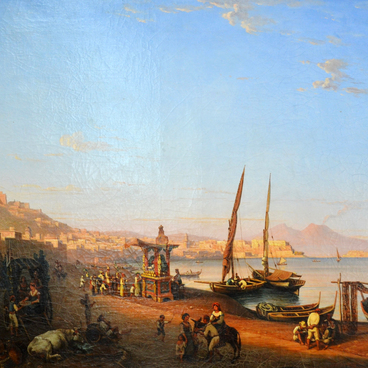Field writing bureaus, small work desks, resembled a box with a slanted top. There are several theories for the origins of this type of ‘organizer’, the most probable of them is that it evolved from a jewelry box of similar design. Jewelry boxes were often used to keep letters, and this function was inherited by field-type or table-top organizers.
The presented exhibit is a box with a two-leaved, slanted front face. There is a drawer at the bottom of the box. There are several horizontal compartments behind the doors meant for papers.
The top part of the front face opens; behind it, there is an additional drawer.
The organizer belonged to the Talyzins from the Denezhnikovo estate of the Bronnitsy District. It was transferred here from the Bronnitsy Museum in 1930. In 2012, it underwent restoration: the structure was reinforced, and internal partitions were repaired with glue. They also restored the lock and fixed the plywood.
Based on the known documents, the Talyzin family tree dates back to the 15th century. The names of its members are found in accounts of many significant events in the history of the Russian state.
The estate ensemble of Denezhnikovo was built by a member of the Admiralty Board since 1748, admiral Ivan Lukyanovich Talyzin (1700–1779). Ivan Lukyanovich was a relative of Nikita Ivanovich Panin, a diplomat in charge of the Russian foreign policy. Another relative of Ivan Talyzin was the Chancellor of the Russian Empire Alexey Petrovich Bestuzhev-Ryumin.
It was he who famously replied to the envoys of Peter III that they should ‘leave the way they came, for he had not seen any Emperor of Russia, and serves faithfully only to the sole Empress of All Russia, Catherine II.’
Eventually, Denezhnikovo passed on to Ivan Lukyanovich’s male heir, Alexander Fyodorovich Talyzin (1731–1787).
Alexander Talyzin played a prominent role in the plot to overthrow Peter III and crown Catherine the Great. The Empress entered Petersburg disguised in Talyzin’s uniform. This uniform was kept as an heirloom by the Apraksin family first in the village of Olgovo in the Moscow Province, and then in Denezhnikovo.
The son of Alexander Talyzin, Stepan (1765–1815), studied in Stuttgart and served in the Izmailovsky Regiment, leaving the army in the rank of lieutenant colonel in 1789. He fought in the Second Russo-Turkish War. Stepan Talyzin served under the command of the renowned Russian general Alexander Suvorov, where he enjoyed the attention of the field marshal.
Suvorov visited the Denezhnikovo estate more than once. In 1795, he became the god-son of Stepan Aleksandrovich Talyzin. Subsequently, the commander’s godson, Alexander, married Suvorov’s granddaughter, Olga Nikolaevna Zubova (1803–1882).
Since then, portraits of the Zubovs and the Suvorovs have been on the walls of the house in Denezhnikovo. The portrait of Alexander Suvorov occupied a special and honorable place. In addition, the estate contained a large collection of the Field-Marshal’s belongings. In the park of the estate, there is an oak, which, according to legend, was planted by Suvorov himself.
After the death of Alexander Stepanovich Talyzin, Denezhnikovo was inherited by his children. In 1918, the estate was nationalized.
The presented exhibit is a box with a two-leaved, slanted front face. There is a drawer at the bottom of the box. There are several horizontal compartments behind the doors meant for papers.
The top part of the front face opens; behind it, there is an additional drawer.
The organizer belonged to the Talyzins from the Denezhnikovo estate of the Bronnitsy District. It was transferred here from the Bronnitsy Museum in 1930. In 2012, it underwent restoration: the structure was reinforced, and internal partitions were repaired with glue. They also restored the lock and fixed the plywood.
Based on the known documents, the Talyzin family tree dates back to the 15th century. The names of its members are found in accounts of many significant events in the history of the Russian state.
The estate ensemble of Denezhnikovo was built by a member of the Admiralty Board since 1748, admiral Ivan Lukyanovich Talyzin (1700–1779). Ivan Lukyanovich was a relative of Nikita Ivanovich Panin, a diplomat in charge of the Russian foreign policy. Another relative of Ivan Talyzin was the Chancellor of the Russian Empire Alexey Petrovich Bestuzhev-Ryumin.
It was he who famously replied to the envoys of Peter III that they should ‘leave the way they came, for he had not seen any Emperor of Russia, and serves faithfully only to the sole Empress of All Russia, Catherine II.’
Eventually, Denezhnikovo passed on to Ivan Lukyanovich’s male heir, Alexander Fyodorovich Talyzin (1731–1787).
Alexander Talyzin played a prominent role in the plot to overthrow Peter III and crown Catherine the Great. The Empress entered Petersburg disguised in Talyzin’s uniform. This uniform was kept as an heirloom by the Apraksin family first in the village of Olgovo in the Moscow Province, and then in Denezhnikovo.
The son of Alexander Talyzin, Stepan (1765–1815), studied in Stuttgart and served in the Izmailovsky Regiment, leaving the army in the rank of lieutenant colonel in 1789. He fought in the Second Russo-Turkish War. Stepan Talyzin served under the command of the renowned Russian general Alexander Suvorov, where he enjoyed the attention of the field marshal.
Suvorov visited the Denezhnikovo estate more than once. In 1795, he became the god-son of Stepan Aleksandrovich Talyzin. Subsequently, the commander’s godson, Alexander, married Suvorov’s granddaughter, Olga Nikolaevna Zubova (1803–1882).
Since then, portraits of the Zubovs and the Suvorovs have been on the walls of the house in Denezhnikovo. The portrait of Alexander Suvorov occupied a special and honorable place. In addition, the estate contained a large collection of the Field-Marshal’s belongings. In the park of the estate, there is an oak, which, according to legend, was planted by Suvorov himself.
After the death of Alexander Stepanovich Talyzin, Denezhnikovo was inherited by his children. In 1918, the estate was nationalized.



